School Programs
Grade 1: Family & Community Identity
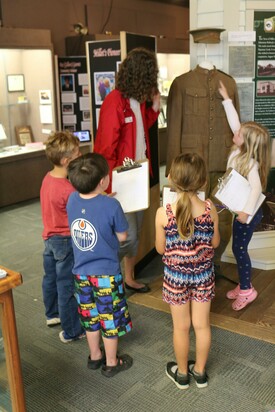
During this field study, you and your students will be looking at family and community identity. Students will study the connections between artefacts and family traditions, between uniforms and group identity, and chores and traditions.
Students are divided into three groups. Each group rotates through different activities and sections of the Museum.
Display Room: Families and Traditions
Students will examine different artefacts in the Display Room and be asked to consider the traditions connected to these artefacts. Students will then be asked to consider if these traditions are similar to any of their own family traditions.
Exhibit Room: Group Identities
Students will examine the connections between uniforms and group identities by handling and examining different uniform hats.
Board Room: Work and Traditions
Students will participate in making butter, while listening to stories of other chores which children traditionally did in the past. Students will be prompted to consider how they would feel about doing these chores, as well as what chores they do.
Grade 2: Community Resources & Foundations
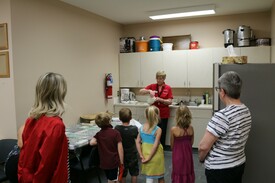
During this field study, you and your students will be looking at how the town of Millet was founded, and how the resources of the community are connected to its foundations and its culture. Specifically, students will learn about the effects of the railroad and agriculture on the community of Millet.
Students are divided into three groups. The groups rotate through the activities in different sections of the Museum.
Display Room: Community Resources -Farming
Students will discuss what it means to be a rural community, as well as what natural resources are present in a rural community. Students will examine different artefacts in the Display Room and be asked to consider how these artefacts were used to process natural resources.
Exhibit Room: Community Resources -The Railway
Students will discuss the geographic location of Millet and the foundation of Millet in relation to the railway. Students will also discuss what types of resources the railway was used to transport in Millet.
Board Room: Experimenting with Resources
Students will experiment with making butter, recording their question, hypothesis, process, and results. Students will discuss the culture of rural communities of the past.
Grade 3: Community Resources & Quality of Life
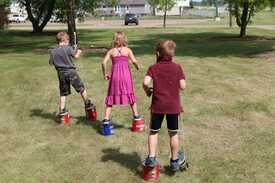
During this field study, you and your students will be looking at the resources and quality of life in Millet in the past and present. Students will study the connections between artefacts and geology, resources, building, and quality of life.
Students are divided into three groups. The groups rotate through the activities in different sections of the Museum.
Display Room: Tools and Building in the Past
Students will examine different artefacts in the Display Room and be asked to consider the different tools which were used in the past. Through interactive activities, the students will study building materials and strategies used in the past.
Exhibit Room: Quality of Life
Students will examine the economy and resources of Millet in both the past and present. Students will compare the resources and quality of Millet past and present to other countries; India, Peru, Tunisia, and Ukraine.
Board Room: Geology
Students will participate in a rock sorting and classifying activity. This activity will explore geology, and develop decision making, problem solving, and pattern recognition skills.
Grade 4: Community Origins & Environment
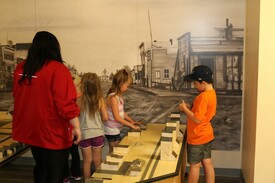
During this field study, you and your students will be looking at the origins of Millet, geography, and environment of Millet. Students will study the connections between artefacts and the fur trade, rural origins of Millet, and Millet’s geography. Students will be given the opportunity to participate in interactive activities exploring the environment and what Millet can do to protect it.
Students are divided into three groups. Each group rotates through different activities and sections of the Museum.
Display Room/Outside: Environment
Students will learn about ways Millet interacts with the environment, including participating in planting.
Exhibit Room: Origins and Geography of Millet
Students will participate in interactive activities to learn more about the origins of Millet, as well as how Millet’s geography has shaped these origins.
Board Room: Origins of Millet
Students will participate in an escape room style fur trade activity. This activity will explore the origins of Millet as a trading post, and develop decision making, problem solving, and pattern recognition skills.
Booking a Field Study
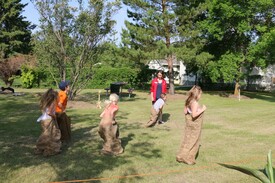
To make arrangements for your field study, please phone the School Program Co-Ordinator at 780-387-5558 and provide the following:
- School name, address, and phone number.
- Teacher's name.
- Grade. If you are teaching a split class, please specify which field study theme you would prefer to focus on.
- Number of students (maximum 30).
- Tentative dates.
- Any pertinent accommodations (i.e. food allergies, students who need worksheets printed on coloured paper, etc.)
We require a minimum of 14 days advance notification. Please inquire about field study costs in your initial request. Our typical rate is $2.50 per student per program (minimum of $40.00), G.S.T. exempt. Programs may be offered at lesser costs based on community sponsorship.
All Field Studies take approximately 2.5 hours to complete. Most contain an outdoor component.
The Museum has Stairchair access to the lower permanent displays.